The F-35 Lightning II fighter has always loomed large in USAF’s air combat plans. The future strength of the multirole and attack fighter inventory depends on it. The service anticipates buying 1,763 of the fighters, using them to replace both the F-16 and A-10. And that need is urgent; those warhorses have reached their retirement ages, and the Air Force is keeping them going with stopgap upgrades.
And now, the F-35’s importance could be about to take a sizeable jump.
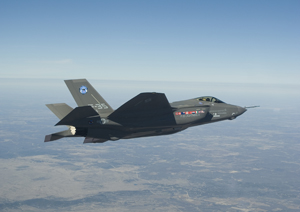 |
The first F-35 test aircraft, a conventional takeoff model, flies a basic flying qualities mission over Texas. |
The cause is a possible premature end of F-22 fighter production. The Bush Administration has done its best to strangle that program short of USAF’s declared minimum need. If the new Administration that takes office in January does nothing to alter the situation, the F-35 will be thrust more and more into the breach.
That is because the F-35 is the preferred—in fact, the only—possible backfill for the Raptor, the world’s most advanced air superiority fighter. If indeed F-22 production stops at 183 aircraft—some 200 airplanes short of the 381 the Air Force long has maintained it needs—then the only reasonable alternative will be increased procurement of the F-35s, said Gen. T. Michael Moseley, who was then USAF Chief of Staff. The alternative would be to accept a dangerous gap in US air capabilities.
The Air Force doesn’t want to trade F-22s for F-35s. Officers make clear that this is no knock on the Lightning. These two fighters were optimized for different purposes; it would be unwise, at this late date, to expect one to do the other’s job with anything like the same degree of capability and efficiency. Still, the decision is largely out of USAF’s hands, and the Air Force will have to live with what’s handed to it.
The good news is that the F-35 program appears to be on track and even slightly ahead of the curve in terms of cost. The Navy and Marine Corps will buy 680 F-35s in an as-yet-undecided mix of short takeoff/vertical landing F-35Bs and somewhat larger, aircraft-carrier-capable F-35Cs. Already, eight foreign nations have partnered with the US to develop the fighter; they plan to buy at least 700 variants for their own air forces. Five other nations have shown interest.
For the United States military services, especially the Air Force, the dominant concern will be numbers. The next six years, at least, will see retirements of old fighters outstripping the purchase of new ones. This will contribute to the so-called “fighter bathtub.” That is a term of art for what shows up on fighter inventory charts when the trend line, over time, declines sharply, bottoms out, and then, at some future date, turns up again and flattens out at a higher plateau. The result looks like a cutaway cross section of a bathtub.
The threatened loss of nearly 200 F-22s in Pentagon political wars would only deepen and extend that bathtub dip. If the new post-Bush Administration decides to terminate the F-22 line, Moseley said, all combat-coded F-22s built would have to be put in the highest spiral development, meaning they must be equipped with advanced capabilities now on the drawing board or planned as upgrades, but not yet necessarily funded.
Fighters Not Interchangeable
Then, Moseley added, the Air Force would have to make up the fifth generation capability in the overall “fighter bathtub” with F-35s.
Fifth generation fighters, in Air Force parlance, are those with a high degree of stealthiness, maneuverability, sensor fusion, and networked communications. This type will be essential to maintaining the credibility of its striking power, said USAF officials. The designation applies to both the F-22 and F-35, at present the only two Gen. 5 fighters in the world.
Moseley, speaking in a May interview, declined to speculate about how many F-35s he thought would be needed to make up for such a gaping shortage of F-22s. He said he remains hopeful that the F-22 program will be continued beyond the current approved run of 183 aircraft.
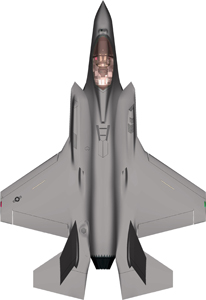 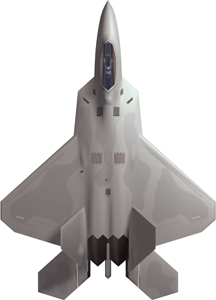 |
left: Computer-generated plan view of the USAF F-35A. |
Moseley maintained that the two aircraft are not interchangeable, in that each was the product of a different design philosophy. The F-22 was the “no compromise” product of an effort to build “the finest air superiority-air dominance fighter in the history of combat aviation,” he asserted, while the F-35 was optimized for affordability, able to meet the multirole needs of the Air Force, Navy, and Marine Corps, with all capabilities tradeable to achieve low cost.
Buying more F-35s to fill the breach would definitely be the second-best option, but the alternative—accepting a gaping hole in the fighter force—would be worse.
Increasing the F-35’s percentage share of the Air Force’s future fighter inventory is exactly what the Pentagon’s civilian leaders have in mind.
Early this year, Defense Secretary Robert M. Gates told Congress he thinks 183 is “probably the right number” of F-22s to buy. He expressed concern that buying more of them would cut into the future purchases of F-35s. His worry, presumably, was that the Navy and Marine Corps would suffer for this. Gates’ deputy, Gordon England, amplified the opinion in a letter to 96 Congressmen, arguing that stealth in all the services (through ownership of the F-35) is preferable to “concentrating” that capability in one service—the Air Force.
John J. Young Jr., Pentagon acquisition, technology, and logistics chief, told the House Armed Services air and land forces subcommittee in March that Defense Department analysis shows “you need a certain number of fifth generation fighters for these high-threat … major combat operations. But to change that mix to a higher-cost F-22 at the expense of the lower-cost Joint Strike Fighter, the studies show variation in there does not change our effectiveness or our loss ratios.”
He was referring to an in-house study, called “Joint Air Dominance,” which was prepared by the Defense Department’s Program Analysis and Evaluation shop. He told the panelists that he would provide classified data to back up the assertion.
Neither Gates or England, nor Young explained why they were casting the F-22 and F-35—always viewed as complementary by the Air Force—as competitors.
However, Young parted the curtain a bit on Pentagon leadership thinking, saying that “it’s hard to see multiple, high-end peers for those high-end threat engagements,” and that top leaders don’t think it’s likely the US would simultaneously engage two peer competitors with advanced aircraft and air defenses. In other words, they feel comfortable with an Air Force sized to cope with one major theater war at a time.
Gates has subsequently observed that fiscal constraints must force tough choices among all weapon systems.
A major question here is the degree of comparability that exists between the two fighters.
Young said he sees the two fighters as “very comparable airplanes.” There are “some distinguishing features,” he allowed, such as the F-22’s “widely publicized supercruise” powers, “but the truth is, they are both highly capable fifth generation fighters with fewer distinguishing features than people offer.”
For his part, the F-35’s current program manager, USAF Maj. Gen. Charles R. Davis, says that the F-35 isn’t in the same class as the F-22. He is quick to add, however, that the F-35 is still a formidable platform and certainly would be able to hold its own against any modern or projected threat.
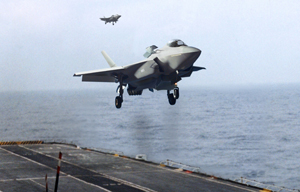 |
The Marine Corps will fly the short takeoff and vertical landing variant. Illustration depicts an F-35B operating from a carrier. |
“I’ll tell you right off, we probably do not have the air show profile that would match a [Su-27] Flanker,” Davis said in an interview. “But we can destroy that Flanker from tens [and] tens of miles away while he’s out doing his air show profile, and never know he’s going to die until he dies.” The F-35’s stealth, he said, gives it “first look, first shot” capability.
Day One or Year Five
“We can fight outnumbered against Flankers and [MiG-29] Fulcrums and prevail in the conventional scenario just about every time,” Davis maintained. In a close-in, visual dogfight, “we will have to work a little bit harder,” he allowed, “but even then, I’m not convinced that we are outclassed in that category, by any stretch of the imagination.”
The F-35, Davis said, was always meant to be a balanced mix of air-to-air and air-to-ground capability. It has the ability to penetrate enemy air defenses in full stealth mode, yet can load up external stations with weapons if stealth is not needed. With full internal weapons, the Air Force version can maneuver at nine Gs, a number equal to that of the F-16 with minimal weapons.
“No other airplane can swing both ways—‘Day One’ stealth or ‘Year Five’ in Iraq, with wingtip to wingtip stores,” Davis asserted.
The services, the program office, and prime contractor Lockheed Martin frequently test the aircraft’s capabilities against threats and other emerging conditions, he said, to ensure that it remains relevant to all kinds of wars.
It is becoming apparent, said Davis, that the F-35 can be kept fresh through every-other-year block upgrades, mainly to incorporate new weapons but also to address emerging threats and other issues as they arise.
Program plans call for the first update, called Block 4, to add a ground-collision avoidance system, an “IR pointer” allowing pilots and ground forces to draw on shared digital maps for target identification, expanded satellite communications, and real-time streaming video.
Block 5 and Block 6 are under review by the program office.
Sometimes, there will be an “out-of-cycle” upgrade to incorporate a particularly pressing item, Davis said. The first of these will be the integration of the Small Diameter Bomb II, now in competition.
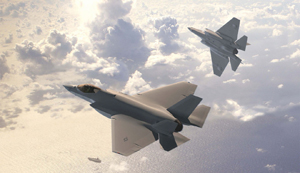 |
The F-35C (shown here in an artist’s conception) will have larger wings and operate from big-deck aircraft carriers. |
The F-35 made news in April when the Pentagon released its selected acquisition reports for 2007. These are the Pentagon’s in-house estimates of the cost of major weapon systems.
The SAR showed that the overall cost of the F-35 program actually declined by nearly a billion dollars in 2007, to just under $299 billion. Those costs include everything from developing and buying the aircraft to building hangars to house them, across the entire life of the program.
“The bottom line,” Davis said in a teleconference with reporters, is that “total acquisition costs of the program [have] slightly decreased. … [Nor has] the average cost of the airplanes increased any since last year.” The performance shows the program is making progress, “not only understanding what the costs are, but being able to control them to some degree. And so, that’s news of note, I think.”
Davis added that negotiations on the second lot of low-rate initial production aircraft “puts the numbers for those airplanes a little bit below even where … the SAR shows they should be.” The LRIP II contract was subsequently announced on May 22, and provided $2.2 billion for 12 aircraft, lower than expected.
The cost drop occurred despite hefty spikes in the cost of raw materials, such as titanium.
This also took place despite some design faults that were uncovered in early flight tests. A significant one was arcing in the actuator system, which brought a test flight to a premature end. The aircraft landed safely—the pilot was largely unaware of the fault—but there was a months-long delay as the actuators were redesigned and installed.
More recently, the “lift fan”—essentially a second engine behind the cockpit, used in the STOVL model—threw a fan blade in testing. The problem is well-understood and a fix will be forthcoming soon, Davis said.
There have been some production setbacks, as well. The F-35 was initially intended to feature a one-piece composite wing. The idea was that a single piece would diminish assembly time and maintenance by sharply reducing the number of fasteners and touch labor required in assembly. It was a good idea in theory, but it didn’t work.
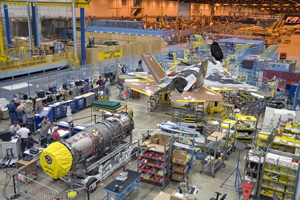 |
Technicians prepare to install the engine of an F-35 at Lockheed Martin’s Fort Worth, Tex., plant. (Lockheed Martin photo) |
Four Parts
“We had to discard quite a bit of tools that were built for that large ‘bat wing,’ and now we’ve gone to a new tooling concept that allows us to go to four individual pieces,” said Daniel J. Crowley, F-35 program manager for Lockheed Martin.
Crowley explained that the large wing was hard to make. Moreover, failure to have all attachment parts ready at the same time would create a production bottleneck. Breaking the process into four smaller parts has sped things up by allowing work to continue on available parts.
Davis said the change was significant; it boosted the cost of early USAF and Marine Corps aircraft—but will end up reducing costs by the same amount on the Navy model, which comes along later in the production run. Over the whole program, the change created a net savings.
Another challenge has been the STOVL system for the F-35B. Davis said the STOVL system is “still up about 20 to 25 percent above what we originally projected” in cost.
However, there has been greater-than-expected “learning curve” benefit from construction of early F-35s, and this will result in larger-than-expected savings early in the run.
“We have found that there is more commonality between the three variants than we predicted,” Crowley reported, and it’s been easier for workers to shift from one variant to another without skipping a beat. Davis also noted that the production F-35s are being built on the same line as the test models, and that has sped up the learning curve and saved money as well.
“With approximately 19 airplanes in production right now,” Davis said in an April teleconference with reporters, “every day we get more actuals [real costs] on what it takes to build an airplane. We also get better every time we build an airplane. … It gives us a better understanding of what jets and later lots will cost.”
The SAR was released within just a couple of weeks of a Government Accountability Office report that blasted the F-35 program, charging that it had increased in cost by $23 billion in a single year and had nearly depleted its management reserves.
Davis, in the telecon, flatly dismissed the GAO report as a cut-and-paste job that reflected outdated information and double-counting of costs in many areas.
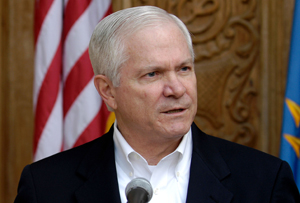 |
Robert Gates, Secretary of Defense |
Bogus Numbers
“We do not agree with that estimate,” Davis said. “There’s no basis for that estimate. They did not do their own assessment to get that estimate and there’s no numbers that support it.”
He explained that the GAO took “other services’ and other agencies’ estimates” and came up with a bogus number.
“They added numbers that were done up to four years ago by other agencies within the Department of Defense,” he said, “and basically added all of the numbers they could find in terms of cost growth.”
Compared with previous fighter programs, “we are two or three years ahead, we’re two or three times better in … the quality off the production line. The numbers show the program is doing well for this early stage.” The good news, he said, is that “we’re going to deal with a lot of the same problems, but we’re going to deal with them earlier.”
One lurking cost challenge, however, is the dropping value of the US dollar. That has made parts purchased from overseas more expensive, while reducing the cost of the aircraft for allied partners.
Britain is a major F-35 development partner. Given the rise of the pound sterling relative to the dollar in recent years, the value of London’s developmental contribution has diminished.
“That change alone has cost the program, to date, about $400 million,” Davis said. The partners will be able to buy “a lot more airplanes” for the same money, but the program is asking them to provide additional funds to help us “offset some of that cost growth” driven by exchange rates. The program is also considering “hedge currency buys to mitigate cost fluctuations” as one way to deal with the problem.
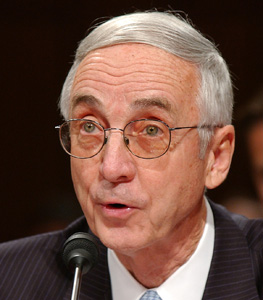 |
Gordon England, deputy SECDEF |
Two aircraft are now on the flight line. Seventeen more are in various stages of construction at Lockheed Martin’s Fort Worth, Tex., facility. With the award of the LRIP II contract, which also starts long-lead items for LRIP III, a total of some 48 F-35s are in the works.
Davis said the STOVL model will accumulate many flights in conventional mode before trying to carry out the kinds of hovering feats achieved by an X-35 concept demonstrator.
“In a disciplined flight-test program, we’ll start at altitude and gradually work it lower and slower until we eventually get to a vertical landing,” something Davis predicts for spring of 2009.
There will be 12 F-35 flight-test aircraft—five Marine Corps STOVL, four Air Force conventional takeoff and landing, and three Navy carrier-capable types. “There’s commonality among them; we’ll learn from each,” said Wilbert D. Pearson Jr., Lockheed Martin vice president for F-35 testing. The CTOLs can accomplish much of the standard flight tests for handling and flight controls.
Overseas Sales
“The mission systems are virtually identical on all three variants, so we only need to test mission systems on one of the airplanes,” Pearson noted.
As matters stand today, the Marine Corps F-35B will be the first to go operational, in 2012. The Air Force follows in 2013, and the Navy in 2015.
Washington expects the foreign partners, taken together, to buy at least 700 fighters, adding more than 30 percent to the overall production level and dramatically reducing the unit cost of the aircraft. They could buy substantially more, which would reduce unit costs even further.
Once the program gets into the fourth production lot, Davis said, a ballpark flyaway cost for the F-35A would be $60 million to $70 million. For the other two variants, the figure would be $80 million to $85 million.
However, he noted that every overseas sale will sharply lower unit cost by spreading overhead over more units. If Israel were to buy 25 aircraft, he said, it would “reduce [the] cost to the US services of almost $500 million. … Every 10, 15, or 20 airplanes that everybody buys has a significant savings in all the rest of the partnership.”
Crowley said the Fort Worth plant will be able to turn out about one F-35 per business day—nominally, 220 per year.
If the Pentagon wants them faster—or if additional foreign orders begin to pile up—the contractor could increase production to as many as 300 fighters per year, by adding shifts, going to weekend work, and using an assembly and checkout plant in Italy.
 |
John Young, DOD acquisition chief |
There has been a sea change in the attitude toward the F-35, both in the Pentagon and on Capitol Hill, Davis observed. He noted that, within the Air Force, there have over the years been some heated F-35 vs. F-22 discussions. In the Navy, it was F-35 vs. F/A-18. The Marine Corps has always liked it.
“I do think folks have realized this is probably the program that’s going to be the cornerstone of [future] tacair,” Davis said.
|
Spreading the Lightning II Far and Wide Eight nations—so far—have signed up for the F-35. If all goes as expected, the program in 2013 will begin to shift over to multiyear procurement, wrapping together foreign and US orders to achieve greater savings. The eight overseas partner nations will receive their F-35s in the following order: Netherlands, Britain, Italy, Australia, Turkey, Denmark, Canada, and Norway. Individual national production numbers have yet to be established. That will be determined when they officially sign their orders, according to Tom Burbage, Lockheed Martin’s F-35 vice president. Each of the partners has contributed money to development and has had a proportional say in setting requirements for the aircraft. Israel and Singapore also participate, but in “observer” status. That means they are planning to buy F-35s but have not played a role in development. In addition, five other countries have shown interest in the F-35: Japan, South Korea, Spain, Belgium, and Greece. All but Greece have entered into at least preliminary negotiations on joining the program. Burbage noted, “Anybody that flies an F-16 has an interest in eventually replacing that airplane.” The F-16 has served in more than 30 air forces. The F-35 also replaces AV-8Bs and F/A-18s, which could add to the list of potential customers. The Air Force projects an overseas market, counting current partner nations, of more than 4,000 F-35s. |
|
Does This Fighter Program Need Two Engines One of the few truly serious problems with the F-35 concerns its engines, and the problem is entirely political. Original plans called for program-long competition between two major engines—the Pratt & Whitney F135 and the General Electric-Rolls Royce F136. Yet when the Pentagon selected the F135 as the winner of the initial production contract, it abandoned the F136, claiming it couldn’t justify two engine suppliers. Congress, meanwhile, has consistently directed it to return to the status quo ante, arguing that an engine competition will end up saving money. Said a frustrated Maj. Gen. Charles R. Davis, F-35 program manager, “I’d either like to have it in for the rest of its life or out. … I don’t care. Pick one.” However, “my plea … would be that it not come out of our basic program lines within JSF, because that would be another perturbation of either cost or production.” He said money will have to be added for a second engine. He noted, “We are nearing a point where … we’ve got to start making some production buy decisions on F136. … We’ve got to do some no-kidding production planning, … and if we continue to do this year-to-year program, it makes it very difficult to do that.” House and Senate Armed Services Committees added F136 funds in their 2009 defense authorization proposals. |